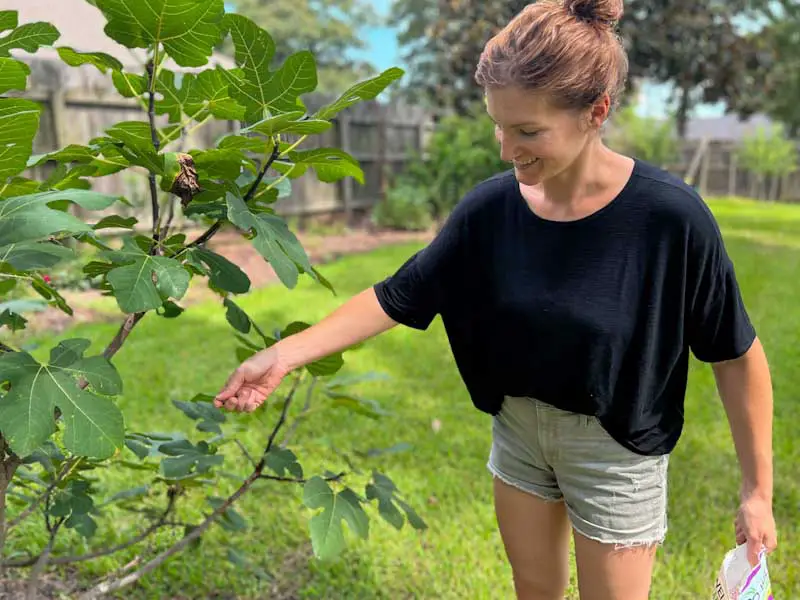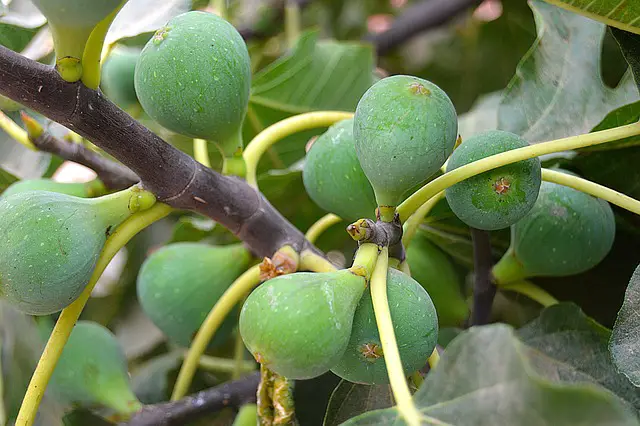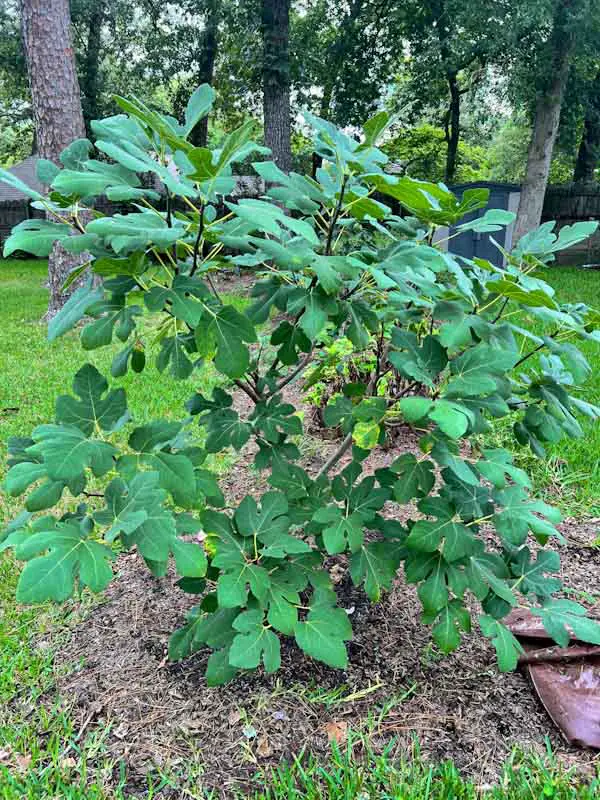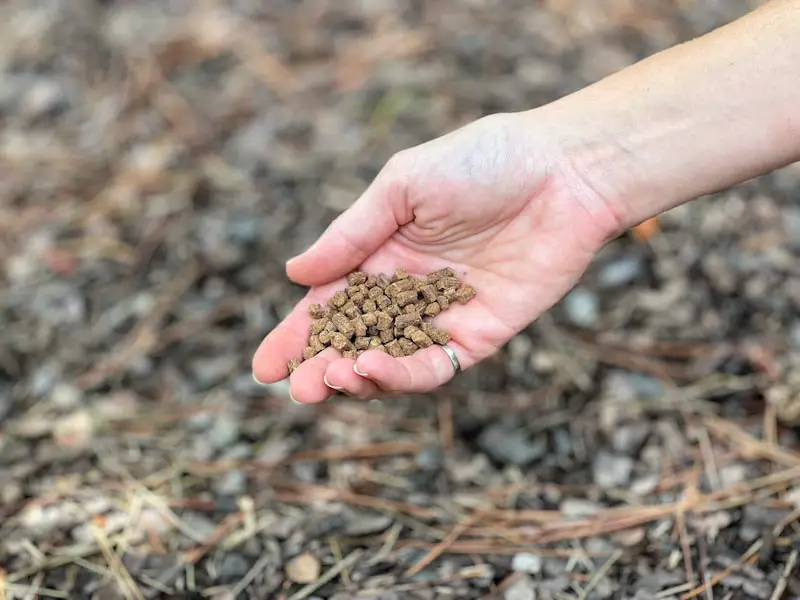It might seem like a good idea to feed your fig tree, but you might want to pause before grabbing the bag of fertilizer. Read on to learn when it’s best to let the tree grow without adding fertilizer to the soil.

We may receive commissions from purchases made through links in this post, at no additional cost to you.
My typical fig tree fertilizer routine used to be random, at best. I would see the lineup of fertilizers on the shelf and think, “Hm. When was the last time I fertilized?” Then I’d grab a handful of any old all-purpose fertilizer and sprinkle it around, and that was that. No harm done, right?
Well, it turns out there could be harm done to fig trees by overfertilizing, feeding at the wrong times, or using the wrong plant food. There are times when a tree does need a boost of nutrition, and a gardener should intervene and fertilize appropriately. But when is it not a good idea to fertilize fig trees?
1. When your tree is providing high-quality, abundant fruit
Congratulations! You have a happily growing, productive fig tree. If you have been pleased with the fig harvest for the last couple of seasons, both in quantity and quality, then chances are your tree is getting the nutrition it needs from the soil. Don’t mess with a good thing.

2. When the tree is fully grown
For the first few years of its life, a young fig tree may need some extra energy (as in, additional nutrients from fertilizer) to establish a healthy root system and growth habit. But with older, more established trees, those extensive roots will probably be able to seek out adequate nutrition – so there’s no need to fertilize.
Fig tree roots are notoriously vigorous and can spread to be about twice the size of the tree’s canopy. A fully grown, comfortably-situated tree can continue growing and producing fruit almost indefinitely.
Learn more: The Lifespan of a Fig Tree: How Long Will It Bear Fruit?
3. When it’s growing too vigorously
A healthy fig tree grows about a foot per year. If your tree is growing more than that, or if its new shoots are longer than about 18 inches, then it may be a sign that you’ve fertilized too much. Why is that a bad thing? Too-vigorous growth can weaken a fig tree and leave it susceptible to disease and cold damage.

The culprit is an excess of nitrogen. Nitrogen supports the growth of leaves and stems. This can be helpful early in the spring to kickstart the growing season. But if your plant has too much leafy growth then its energy is going to the wrong thing – forming leaves instead of figs. Your fig tree may produce very little fruit, if any. If your fig tree is growing too fast, then lay off the fertilizer.
4. When it’s getting nutrients from other sources
This is a sneaky one. Those wide-spreading fig tree roots have the ability to wander all over your yard and absorb nutrients and moisture. Even if your fig tree’s growing conditions aren’t ideal, the roots may be getting extra food (particularly nitrogen) from the fertilized lawn nearby.
If you have planted certain plants nearby (such as nitrogen-producing beans and peas, or the nutrient-rich flowering plant comfrey), then your fig tree may be benefitting from the nutrients they provide.
Learn more: Fig Companion Plants: What to Plant and What to Avoid
Watch: Do you want to know what to if your fig tree does actually need fertilizing? Watch the video below to see exactly why and how I fertilize my fig trees.
Beware, though, of excess nitrogen. All of this nutrition can be a good thing for your fig tree, but if you combine it with additional fertilizer then it may cause a problem.
5. When you see cracks in the trunk or branches
Cracking is often caused by too much fertilization, particularly with a high concentration of, again, nitrogen. The fig tree grows too aggressively, which causes the trunk and branches to split. These cracks expose the more tender inner part of the tree and can encourage disease, pests, and other issues.
When the cold weather comes, cracked branches will most likely lead to frost damage, which can badly damage or kill the tree. If it’s too late and you notice splits in your fig tree’s stem or branches, you can protect it by wrapping the tree before cold weather sets in.
6. When it’s too early in the season
Fig trees spend the winter in dormancy (a period of slow or no growth) before waking up in early spring. The first signs of life you’ll see are little buds of green peeking out of the stems. If you fertilize a fig tree too early – before you are positive that there will be no more frosts – then it will signal the tree to start growing. The tender buds will likely be killed by a late frost, and your tree will be set back for the whole year. (Find the average first and last frost date for your area here.)

7. When it’s too late in the season
At the end of the growing season, after you’ve harvested all those delicious figs, your fig tree has a new job. It no longer needs to grow leaves, set fruit, or ripen fruit. Its task is to start winding down and preparing for the winter dormant period.
If you fertilize a fig tree too late in the season (after the ripe figs have fallen or been picked), it signals to the plant that it’s time to get growing again. New growth at this stage can make the fig tree more sensitive to cold and prone to severe frost damage. Hold off on fertilizing your fig tree until it wakes up again in early spring.
8. When you’re using the wrong fertilizer
There are hundreds of kinds of fertilizers, and each has its purpose. That’s part of what makes the topic of fertilization so confusing. If you use the wrong type or do it at the wrong time, it can disrupt the growing cycle or even harm the plant.
Learn more about the details of fertilizing figs here: When to Fertilize Fig Trees: A Complete Guide

For instance, take slow-release fertilizer vs. soluble fertilizer. The best general fertilizer for fig trees planted in the ground is a granular, organic, slow-release formula with balanced NPK (nitrogen, phosphorus, and potassium concentration), such as Dr. Earth Fruit Tree Fertilizer (which is what I use the most on my fig trees). The microorganisms present in the soil will break down the fertilizer over time, enhancing the health of the soil and making nutrition available to the tree.
A soluble, or liquid, fertilizer may still give the fig tree some small benefits; however, this is a very inefficient way to feed in-ground trees. Plants can absorb nutrients from soluble fertilizer quickly, but those nutrients will wash through the soil too fast to be of much benefit. You’re better off saving your money and sticking with slow-release fertilizers for your in-ground fig trees.
On the other hand, slow-release fertilizers aren’t as helpful to fig trees grown in containers. A fig tree’s roots are restricted in the pot, and so there are fewer roots available to absorb nutrition. The nutrients quickly leach out of the potting soil because of the frequent watering necessary to grow potted fig trees.
There simply is not a robust enough microbiome present in the pot to break down the slow-release fertilizer quickly. For best results with your potted fig tree, stick with the “fast food” of fertilizers and choose a soluble formula.
Learn more: How to Grow Figs in Containers: A Complete Guide

